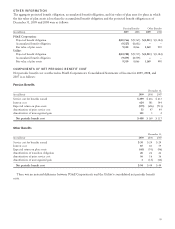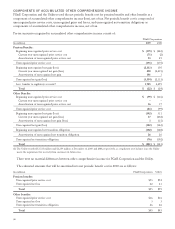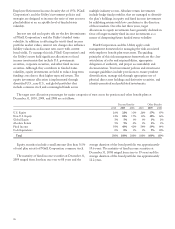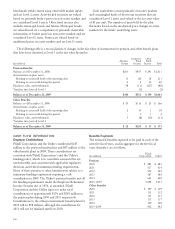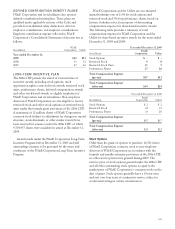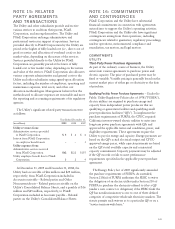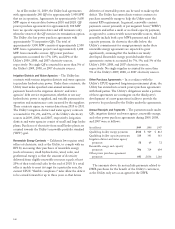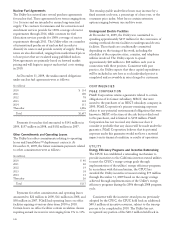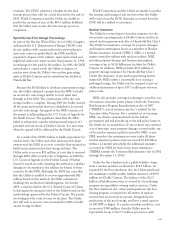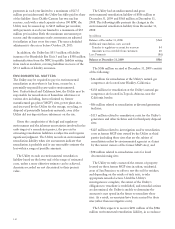PG&E 2009 Annual Report Download - page 109
Download and view the complete annual report
Please find page 109 of the 2009 PG&E annual report below. You can navigate through the pages in the report by either clicking on the pages listed below, or by using the keyword search tool below to find specific information within the annual report.
NOTE 15: RELATED
PARTY AGREEMENTS
AND TRANSACTIONS
The Utility and other subsidiaries provide and receive
various services to and from their parent, PG&E
Corporation, and among themselves. The Utility and
PG&E Corporation exchange administrative and
professional services in support of operations. Services
provided directly to PG&E Corporation by the Utility are
priced at the higher of fully loaded cost (i.e., direct cost of
good or service and allocation of overhead costs) or fair
market value, depending on the nature of the services.
Services provided directly to the Utility by PG&E
Corporation are generally priced at the lower of fully
loaded cost or fair market value, depending on the nature
and value of the services. PG&E Corporation also allocates
various corporate administrative and general costs to the
Utility and other subsidiaries using agreed-upon allocation
factors, including the number of employees, operating and
maintenance expenses, total assets, and other cost
allocation methodologies. Management believes that the
methods used to allocate expenses are reasonable and meet
the reporting and accounting requirements of its regulatory
agencies.
The Utility’s significant related party transactions were
as follows:
Year Ended December 31,
(in millions) 2009 2008 2007
Utility revenues from:
Administrative services provided
to PG&E Corporation $5 $4 $4
Interest from PG&E Corporation
on employee benefit assets ––1
Utility expenses from:
Administrative services received
from PG&E Corporation $62 $122 $107
Utility employee benefit due to PG&E
Corporation 324
At December 31, 2009 and December 31, 2008, the
Utility had a receivable of $26 million and $29 million,
respectively, from PG&E Corporation included in
Accounts receivable – Related parties and Other
Noncurrent Assets – Related parties receivable on the
Utility’s Consolidated Balance Sheets, and a payable of $16
million and $25 million, respectively, to PG&E
Corporation included in Accounts payable – Related
parties on the Utility’s Consolidated Balance Sheets.
NOTE 16: COMMITMENTS
AND CONTINGENCIES
PG&E Corporation and the Utility have substantial
financial commitments in connection with agreements
entered into to support the Utility’s operating activities.
PG&E Corporation and the Utility also have significant
contingencies arising from their operations, including
contingencies related to guarantees, regulatory proceedings,
nuclear operations, environmental compliance and
remediation, tax matters, and legal matters.
COMMITMENTS
UTILITY
Third-Party Power Purchase Agreements
As part of the ordinary course of business, the Utility
enters into various agreements to purchase power and
electric capacity. The price of purchased power may be
fixed or variable. Variable pricing is generally based on the
current market price of either gas or electricity at the date
of purchase.
Qualifying Facility Power Purchase Agreements — Under the
Public Utility Regulatory Policies Act of 1978 (“PURPA”),
electric utilities are required to purchase energy and
capacity from independent power producers that are
qualifying co-generation facilities and qualifying small
power production facilities (“QFs”). To implement the
purchase requirements of PURPA, the CPUC required
California investor-owned electric utilities to enter into
long-term power purchase agreements with QFs and
approved the applicable terms and conditions, prices, and
eligibility requirements. These agreements require the
Utility to pay for energy and capacity. Energy payments are
based on the QF’s actual electrical output and CPUC-
approved energy prices, while capacity payments are based
on the QF’s total available capacity and contractual
capacity commitment. Capacity payments may be adjusted
if the QF exceeds or fails to meet performance
requirements specified in the applicable power purchase
agreement.
The Energy Policy Act of 2005 significantly amended
the purchase requirements of PURPA. As amended,
Section 210(m) of PURPA authorizes the FERC to waive
the obligation of an electric utility under Section 210 of
PURPA to purchase the electricity offered to it by a QF
(under a new contract or obligation) if the FERC finds the
QF has nondiscriminatory access to one of three defined
categories of competitive wholesale electricity markets. The
statute permits such waivers as to a particular QF or on a
“service territory-wide basis.”
105


